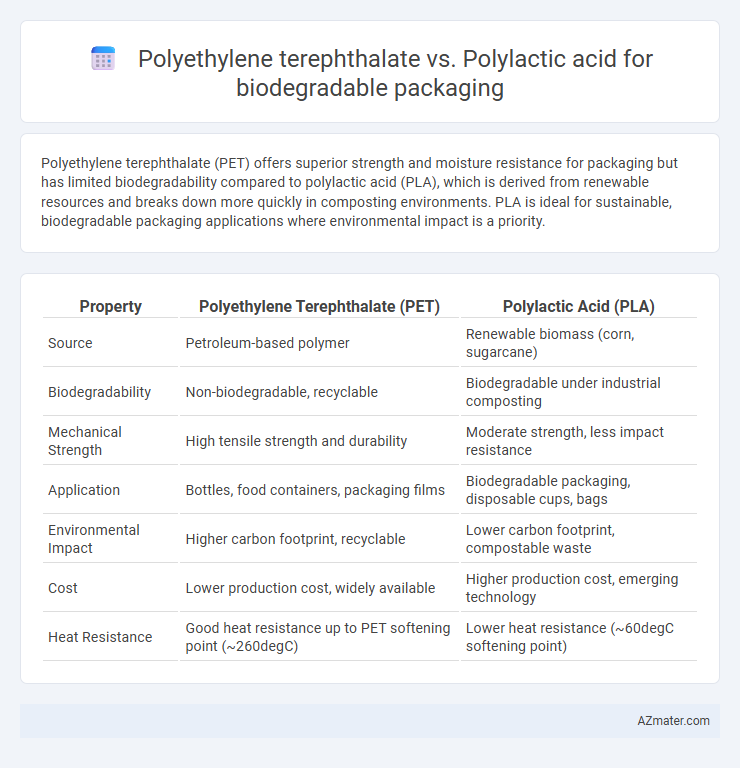Polyethylene terephthalate (PET) offers superior strength and moisture resistance for packaging but has limited biodegradability compared to polylactic acid (PLA), which is derived from renewable resources and breaks down more quickly in composting environments. PLA is ideal for sustainable, biodegradable packaging applications where environmental impact is a priority.
Table of Comparison
| Property | Polyethylene Terephthalate (PET) | Polylactic Acid (PLA) |
|---|---|---|
| Source | Petroleum-based polymer | Renewable biomass (corn, sugarcane) |
| Biodegradability | Non-biodegradable, recyclable | Biodegradable under industrial composting |
| Mechanical Strength | High tensile strength and durability | Moderate strength, less impact resistance |
| Application | Bottles, food containers, packaging films | Biodegradable packaging, disposable cups, bags |
| Environmental Impact | Higher carbon footprint, recyclable | Lower carbon footprint, compostable waste |
| Cost | Lower production cost, widely available | Higher production cost, emerging technology |
| Heat Resistance | Good heat resistance up to PET softening point (~260degC) | Lower heat resistance (~60degC softening point) |
Introduction to Biodegradable Packaging
Biodegradable packaging materials like Polyethylene terephthalate (PET) and Polylactic acid (PLA) are critical in reducing environmental impact from plastic waste. PET, a petroleum-based polymer, offers durability and clarity but degrades slowly, contributing to long-term pollution. PLA, derived from renewable resources such as corn starch, provides compostability and faster biodegradation, making it a sustainable alternative for eco-friendly packaging solutions.
Overview of Polyethylene Terephthalate (PET)
Polyethylene terephthalate (PET) is a widely used thermoplastic polymer derived from petroleum, known for its strength, transparency, and excellent barrier properties against moisture and gases, making it ideal for packaging applications. Despite its recyclability, PET is not inherently biodegradable, which raises environmental concerns in single-use packaging. Advances in recycling technologies and the development of bio-based PET variants aim to reduce its carbon footprint compared to traditional fossil-fuel-based plastics.
Overview of Polylactic Acid (PLA)
Polylactic Acid (PLA) is a biodegradable thermoplastic derived from renewable resources such as corn starch and sugarcane, offering a sustainable alternative to conventional petroleum-based plastics like Polyethylene Terephthalate (PET). PLA exhibits excellent clarity, compostability under industrial conditions, and a lower carbon footprint, making it highly suitable for eco-friendly packaging applications. Its biodegradation process results in lactic acid, which is non-toxic and environmentally benign, contrasting with the persistent nature of PET plastics in landfills.
Environmental Impact: PET vs PLA
Polyethylene terephthalate (PET) is a petroleum-based polymer with limited biodegradability, persisting in the environment for hundreds of years and contributing to microplastic pollution. Polylactic acid (PLA) is derived from renewable resources such as corn starch and offers compostability under industrial conditions, reducing landfill accumulation and carbon footprint. While PLA decomposes faster in controlled settings, its environmental impact depends on proper disposal infrastructure, whereas PET recycling is more established but less effective in mitigating long-term ecological harm.
Biodegradability and Compostability Comparison
Polyethylene terephthalate (PET) is a durable plastic commonly used in packaging, but it is not biodegradable and requires industrial recycling processes to minimize environmental impact. Polylactic acid (PLA), derived from renewable resources like corn starch, offers superior biodegradability and compostability under industrial composting conditions, breaking down into water, carbon dioxide, and biomass within months. While PET's resistance to degradation limits its ecological benefits, PLA enables a more sustainable packaging solution by facilitating a closed-loop lifecycle in waste management systems.
Mechanical and Barrier Properties
Polyethylene terephthalate (PET) exhibits superior mechanical strength and excellent barrier properties against gases and moisture, making it ideal for durable packaging applications. Polylactic acid (PLA), while biodegradable and compostable, generally offers lower tensile strength and weaker barrier performance, which can limit its use in high-demand packaging environments. Innovations in PLA blending and coating aim to improve its mechanical resilience and barrier efficiency, narrowing the gap with traditional PET materials.
Applications in Packaging Industry
Polyethylene terephthalate (PET) is widely used in the packaging industry for its strength, transparency, and barrier properties, making it ideal for beverage bottles and food containers. Polylactic acid (PLA), derived from renewable resources like corn starch, is favored for compostable packaging applications such as disposable cups, trays, and biodegradable films. While PET offers superior durability and recyclability, PLA provides an environmentally-friendly alternative with lower carbon footprint and enhanced compostability for single-use packaging solutions.
Cost Efficiency and Market Availability
Polyethylene terephthalate (PET) exhibits greater cost efficiency due to its widespread production economies and established recycling infrastructure, making it a dominant choice in packaging markets. Polylactic acid (PLA), derived from renewable resources like corn starch, remains more expensive due to limited scaling and higher raw material costs, but it offers superior biodegradability under industrial composting conditions. Market availability favors PET with extensive global supply chains, while PLA is regionally constrained but growing rapidly in response to increasing demand for sustainable packaging solutions.
Recycling and End-of-Life Options
Polyethylene terephthalate (PET) offers high recyclability through established mechanical and chemical recycling processes, enabling efficient recovery and reuse in packaging. Polylactic acid (PLA), while compostable under industrial conditions, faces limited recycling infrastructure and slow degradation in natural environments, restricting its circular lifecycle potential. End-of-life options for PET favor closed-loop recycling systems, whereas PLA primarily relies on industrial composting facilities, impacting overall sustainability performance in biodegradable packaging applications.
Future Prospects and Innovations
Polyethylene terephthalate (PET) remains dominant in packaging due to its durability and recycling infrastructure, but emerging innovations in polylactic acid (PLA) enhance its biodegradability and feedstock sustainability, positioning it as a prime candidate for future eco-friendly packaging solutions. Advances in PLA production include genetically engineered microorganisms for efficient lactic acid synthesis and novel composite blends that improve thermal resistance and mechanical strength, accelerating PLA's adoption in various industries. Research into chemical recycling and enzymatic degradation technologies further improves PLA lifecycle management, potentially overcoming current limitations and driving a shift toward fully biodegradable packaging systems.

Infographic: Polyethylene terephthalate vs Polylactic acid for Biodegradable Packaging
 azmater.com
azmater.com